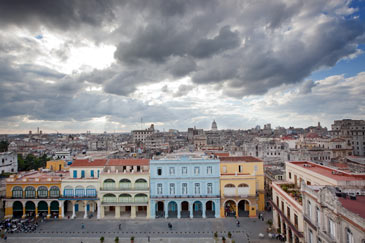- / World & News
- / Countries of the World
- / Cuba
- / Cuba: Photo Slideshow
Cuba: Photo Slideshow
photos by Carol M. Highsmith
- Havana, Cuba

- The capital and Cuba's largest city, Havana boasts more than 2.5 million inhabitants. Havana is also one of the America's oldest cities, founded in 1515 by the Spanish explorer Diego de Velázquez on Cuba's southern coast and relocated to the site of present-day Havana in 1519. Now a truly modern metropolis, this bustling port is known for its exuberant nightlife, iconic cigars, and mesmerizing dances-the samba and salsa.
- José Martí Memorial
![Jose Marti Memorial, Revolution Square, Havana, Cuba]()
- The José Martí Memorial on Revolution Square in Havana stands tall on one of the world's largest city squares, measuring 775,001.545 sq ft (72,000 sq m). Dedicated to José Martí, a symbol of Cuba's bid for independence against Spain in the 19th century, the memorial consists of a 358- foot-tall (109 m), star-shaped tower and a white marble sculpture depicting this local hero. This sculpture has kept company with the likes of Fidel Castro and Pope John Paul II, both of whom have addressed crowds a million strong gathered in the square.
- Cuban dancers
![]()
- Zanqueros, or stilt-dancers, are an important part of Cuba's desire to celebrate its heritage through entertainment. The flamboyant art of stilt dancing arrived in the Caribbean with West African slaves. "Moko jumbie" is a dance of the spirits of the dead. The "moko" or "mocker" must be tall enough to reach the spirits, and powerful enough to cast them out.
- Hotel Nacional
![]()
- The Hotel Nacional in Havana, sited on the Taganana hill, overlooks the San Lazaro cove-a legendary pirate landing spot. This "Enchanted Castle" was inaugurated the evening of December 30, 1930. After 60 years of operation by its American owner, the Cuban government took over the building. In 1992 it went through a general restoration that mostly preserved all the eclectic splendor of its Art Deco past mixed with more modern influences. During the 19th century, the hill on which the hotel stands held the famous battery of Santa Clara. The Ordoñez cannon, one of the largest of its time, still lies in the hotel's gardens.
- Hemingway's office
![]()
- Considered one of the greatest writers of all time, Ernest Hemingway wrote For Whom the Bell Tolls and The Old Man and the Sea in his home outside of Havana, which he called Finca Vigia (Lookout Farm). Hemingway's office has not been changed since he last put pen to paper before leaving Cuba for Idaho in 1960. Awarded the Pulitzer Prize in 1953 and the Nobel Prize for Literature in 1954, Hemingway was increasingly plagued by ill health and mental problems, and in July 1961, he committed suicide by shooting himself.
- Chinatown
![]()
- Barrio Chino (Chinatown) is often a surprise to visitors to Havana. But the Chinese population has a long history in Cuba, with large numbers first arriving on the Spanish frigate Oquendo in 1847 to work on sugar plantations as indentured servants. The second wave of Chinese settlement took place from 1860 through 1875 with newcomers from California seeking refuge from anti-Chinese sentiment and laws. Wealthier than previous Chinese immigrants, the "Californians" helped lay the economic foundation of Havana's Chinatown.
- Paseo del Prado
![]()
- The Paseo del Prado is a mile-long promenade that begins at Havana's Central Park Hotel and leads to the sea. Constructed in the 18th century, the Paseo is a major destination for locals and tourists alike. Watching over all this bustling activity are the lions of the paseo-sculptures cast using the cannons that once fortified Havana against corsairs and pirates.
- Malecon
![]()
- El Malecon is a seawall, esplanade, and major transportation artery that extends about 4 miles (7 km) along the ocean in Havana. Famed for its spectacular sunsets, the Malecon is a popular spot for walking, fishing, and romancing.
- Costumes
![]()
- Two Cuban women dressed in colorful costumes pose in the square in front of the church and monastery of San Francisco de Assisi. Once the home of Franciscan monks, the basilica and monastery now serve as a museum and concert hall. Visitors can view the catacombs that have been excavated, as well as a crystal Jesus figure given by Mother Teresa to Fidel Castro.
- Capital City
![]()
- In its position at the entrance of the Gulf of Mexico, only miles from Florida, Cuba is often viewed as a country of contradictions. Havana typifies the Cuban paradox. The old city continues to benefit from a multimillion-dollar renovation program in an attempt to woo tourists, while the crumbling infrastructure lies vulnerable to the winter storms and violent hurricanes. While 50 years of socialism have taken a toll on the economic and social framework of the city, the spirit of Havana's people remain unbroken and full of vibrancy and life.
Related LinksCarol M. Highsmith, a distinguished and widely published American photographer, began donating her work to the Library of Congress in 1992. The Carol M. Highsmith archive at the Library of Congress includes photos from each of the United States and is expected to eventually contain 100,000 photos. Professionally printed and framed prints of these photos are available at PhotographsAmerica.com. |










